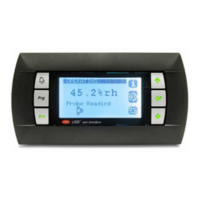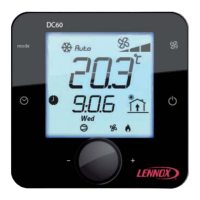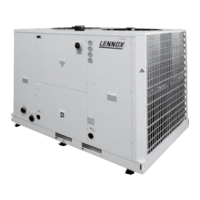4
WIRELESS
Function
The CAREL© / LENNOX© Wireless system is designed for all HVAC/R applications that require the monitoring of the
ambient conditions (temperature and for the future humidity) and/or the control of the ambient comfort based on the
requirements of the end user (operating mode, set point, …).
Description
Wireless is made up of:
• DCw (display):
An innovative wireless terminal with integrated sensors for measuring the temperature and humidity.
With the Climatic™ Roof-Top soft is it possible to have au maximum 1 DCw by unit.
• SCw (sensor):
Wireless sensors that measure the temperature and humidity.
With the Climatic™ Roof-Top soft is it possible to have au maximum 6 SCw by unit.
• APw (access point):
RS485/ZigBee™ gateway hat collects the information from the terminals and sensors.
With the Climatic™ Roof-Top soft is it possible to have au maximum 1 APw by unit.
• ARw (repeater):
ZigBee™ to ZigBee™ device that relays the wireless signals, allowing greater distances between the access point
and terminals or sensors
The Humidity management and the repeater are not currently available
Terminology
Wireless
Wireless means “without wires”, in contrast to the term “wired”.
Wireless network
Telecommunications system (series of devices, appliances, methods and protocols) for the transmission of information
via radio, typically radiofrequency technology used instead of wired connections, making the systems particularly flexible.
ZigBee™
Zigbee™ is a set of specifications based on the IEEE-802.15.4 standard for the creation of Wireless Personal Area
Networks (WPAN).
Comparable in some ways to Bluetooth, it stands out for its very low power consumption and the reduced cost of
implementation, despite having a maximum data transfer speed of 250 Kbit/s.
ZigBee™ devices, with compact dimensions and low costs, are designed to work in dedicated self-organised networks
(Mesh networks) and are used in many fields.
Advantages of the wireless solution
Advantages of a wireless network over a wired network
Mobility of the terminals;
Ease of installation and connection of the devices;
Coverage even where obstacles are present;
Flexibility in the event of structural modifications;
Reduction in wiring costs;
Scalability in the interconnection of terminals;
Sturdiness.
The advantages of wireless networks can overcome some of the intrinsic limits in wired systems.
Advantages of ZigBee™
Standard technology;
Reduced costs ;
Can be used globally;
Reliable;
Supports a large number of nodes;
Easy configuration;
Long battery life;

